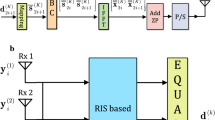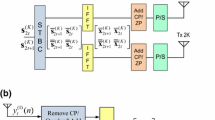Abstract
In this paper, we propose a two-stage linear multiuser detector (LMD) for ultra wideband (UWB) multiple single-input multi-output (M-SIMO) system and multipath fading environment. Time-hopping (TH) and antipodal pulse amplitude modulation (PAM) are employed for the multiple access system. The decorrelating detector is first employed at the front end of each receive antenna to eliminate the multi-user interference (MUI), then a set of maximum-ratio-combiners (MRC) are proceeded to maximize the signal-to-noise power ratio (SNR) for each user. Since the channel information is crucial for the Decorrelating-MRC (D-MRC) receiver, we develop a subspace-based blind M-SIMO channel estimation method. The effect of channel estimation error on system performance is extensively evaluated. It is also verified from the analytical and numerical results that by exploiting both spatial and temporal diversities, the D-MRC receiver dramatically improves system performance even without additional coding. Moreover, we demonstrate that both the D-MRC receiver and subspace-based blind channel estimator are computationally feasible and near-far resistant.
Similar content being viewed by others
References
Win, M. Z., Scholtz, R. A. (April 2000). Ultra wide bandwidth time-hopping spread-spectrum impulse radio for wireless multiple access communications. IEEE Transactions on Communications, 48(4), 679–691.
Win, M. Z., Scholtz, R. A., & Barnes, M. A. (June 1997). Ultra-wide bandwidth signal propagation for indoor wireless multiple access communications. In Proc. IEEE Int. Conf. Communications (Vol. 1, pp. 56–60). Montreal, Canada.
Win, M. Z., & Scholtz, R. A. (February 1998). On the robustness of ultra-wide bandwidth signals in dense multipath environments. IEEE Communication Letters, 2(2), 51–53.
Welborn, M. L. (2001). System considerations for ultra-wideband wireless networks. In IEEE Radio and Wireless Conference (pp. 5–8).
Win M.Z., Scholtz R.A. (1998) Impulse radio: How it works. IEEE Communications Letters 2(2): 36–39
Scholtz, R. A. (1993). Multiple access with time-hopping impulse modulation. In Proc. MILCOM’93 (Vol. 2, pp. 447–450).
Mireles, F. R. (June 2001). Performance of ultrawideband SSMA using time hopping and M-ary PPM. IEEE Journal of Selected Areas: Communication, 19(6), 1186–1196.
Zhao, L., & Haimovich, A. M. (2002). Multiuser capacity of M-ary PPM ultra-wideband communications. In 2002 IEEE Conference on Ultra Wideband Systems and Technologies (pp. 175–179).
Siriwongpairat, W., Olfat, M., & Ray Liu, K. J. (2004). Performance analysis of time hopping and direct sequence UWB space–time systems. In IEEE GLOBECOM (pp. 3526–3530).
Siriwongpairat, W., Olfat, M., & Ray Liu, K. J. (March 2004). On the performance evaluation of TH and DS UWB MIMO systems. In IEEE Wireless Communications and Networking Conference (pp. 1800–1805).
Price, R., & Green, P. E. (March 1958). A communication technique for multipath channel. Proceedings of the IRE, 46(3), 555–570.
Verdu S. (1998) Multiuser detection. Cambridge University Press, Cambridge
Schmidt, R. O. (March 1986). Multiple emitter location and signal parameter estimation. In IEEE Transactions on Antennas and Propagation, AP-34, 276–290.
Liu, H., & Xu, G. (Oct 1996). A subspace method for signature waveform estimation in synchronous CDMA systems. IEEE Transaction Communication, COM-44, (10), 1346–1354.
Saleh A.A.M., Valenzuela R.A. (1987) A statistical model for indoor multipath propagation. IEEE Journal on Selected Areas in Communication 5(2): 128–137
Molisch A.F. et al (2006) A comprehensive standardized model for ultrawideband propagation channels. IEEE Transactions on Antenna and Propagation 54(11): 3151–3165
Cassioli, D., Win, M. Z., & Molisch, A. F. (Aug.2002). The ultra-wide bandwidth indoor channel: from statistical model to simulations. IEEE Journeal on Selected Areas Communication, 20(6), 1247–1257.
Wang, L. C., Liu, W. C., & Shieh, K. J. (Nov. 2005). On the performance of using multiple transmit and receive antennas in pulse-based ultrawideband systems. IEEE Transactions on Wireless in Communications, 4(6), 2738–2750.
Yang, L., & Giannakis, G. B. (November 2004). Ultrawideband communications: An idea whose time has come. IEEE Signal Processing Magazine, 21(6), 26–54.
Zhiwei, L., & Madhukumar, A. S. (Sept. 2004). MMSE detection for high data rate UWB MIMO systems. IEEE Vehicular Technology Conference, 2, 1463–1467.
Wang, Y., & Dong, X. (April 2006). A time-division multiple access SC-FDE system with IBI suppression for UWB communications. IEEE Journal on Selected Areas in Communication, 24(4), 920–925.
Xu, Z., & Tang, J. (June 2006). Blind channel estimation in aperiodic time-hopping ultra-wideband communications. IEEE Transaction on Signal Processing, 54(6), 2333–2346.
Author information
Authors and Affiliations
Corresponding author
Rights and permissions
About this article
Cite this article
Wu, WC. A Decorrelating-MRC Based Space–Time Multiuser Receiver for Time-Hopping UWB System. Wireless Pers Commun 50, 275–289 (2009). https://doi.org/10.1007/s11277-008-9589-8
Received:
Accepted:
Published:
Issue Date:
DOI: https://doi.org/10.1007/s11277-008-9589-8




